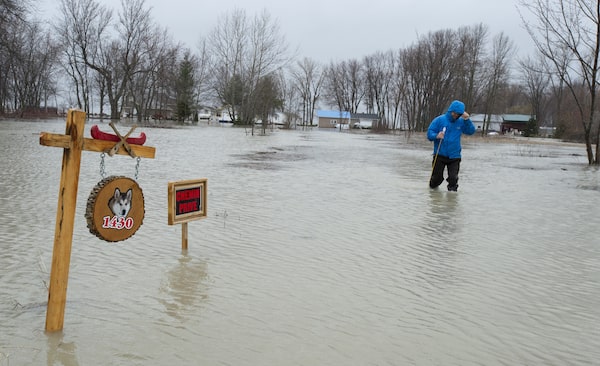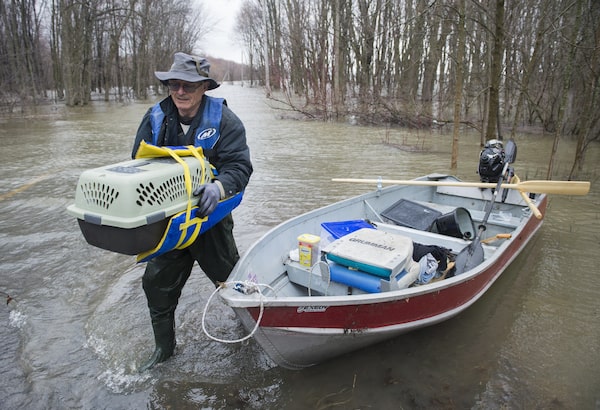A flooded house is seen in this aerial photo taken from Canadian Armed Forces helicopters surveying the flood regions of the Saint John River Valley, near Fredericton, on April 24, 2019.Supplied/Reuters
It was not long ago that the quaint waterfront bungalow with cedar shingles on Penny Roadway seemed to Lisa Sanderson like a Maritime dream.
She and her wife, Juliette Bosse, bought the place six years ago and put their stamp on its exterior, adding a cheery, hand-painted mailbox, a pair of oversized blue tin stars and a swimming pool.
All of it went from feeling like home to handcuffs this week.
For the second year in a row, the Saint John River flooded their property with record levels of water, swamping their detached garage with chest-level swells that threaten to carry it away. Six pumps whirred around the clock, slurping up water as it seeped up through the basement floor while waves sloshed against a growing wall of sandbags packed around the house. A group of friends and family adds bags to the wall daily in what has become a race to outpace rising flood waters.
They are trying to preserve both the home and a way of life that seems, quite suddenly, unsustainable.
Montreal declares state of emergency, Canadian Forces arrive in Ottawa as flood waters set to rise
“People from afar will say, ‘Why do you live there?’ Well, when we moved here, water wasn’t a threat. Water had never even come close to our house until last year,” said Ms. Sanderson, a music teacher.
“We work so hard to be able to come home here, to this life we have built,” she said, her shoulders slumping with defeat. “But once this happens, you’re stuck.”
Scenes such as the one on Penny Roadway are playing out across a huge swath of southern New Brunswick, where flooding forced hundreds of people to abandon their homes, shuttered schools and highways, and downed power lines. The province’s Emergency Measures Organization (EMO) said water levels were originally forecast to peak on Friday but “significant rain” predicted for the weekend could mean the highest water is yet to come.
“We’re not at the recovery stage of this yet,” warned Greg MacCallum, director of the N.B. EMO. “Precipitation … ebbs and flows. This is going to be a slow burn. It’s going to take some days.”

A man walks down a street in a flooded neighbourhood in Yamachiche, Que. on April 26, 2019.Paul Chiasson/The Canadian Press
Minor seasonal flooding has always been a way of life in N.B.’s southern riverside communities. But when this year’s flood levels began contending with the highs seen in 2018 – a flood billed then as historically destructive – many began wondering how many more years like this they can endure.
“If we take water this year, that’s it. We can’t come back. We’re not doing it again,” Doug Frader, a Saint John resident, said this week. His cottage property is on Grand Lake, one of the hardest-hit flood zones.
Taking a break from filling sandbags for a friend, Mr. Fraser’s wife, Lori, agreed.
“We can’t keep coming back,” she said. “It’s too hard physically and mentally.”
Few have the option of simply abandoning their property, though.
“If people could just move, they would. It’s never that easy,” said Bill Lawlor, the Canadian Red Cross provincial director for New Brunswick. “Your mortgage on your home doesn’t just disappear because your home has been faced with a tragedy,” he said. "There are all kinds of financial implications that make it difficult for a family to figure out what their next steps will be.”

William Bradley removes a pet from a small boat next to a flooded street in Rigaud, Que.Graham Hughes/The Canadian Press
Evacuations from the flood zone have thus far been voluntary. As of Friday, nearly 1,000 people had registered with the Red Cross after having to abandon their homes. Seventy per cent of those registered were also forced out of their homes last year and some had only just been able to return, Mr. Lawlor said.
“This is going to create some potentially significant hardship for families,” he said.
While the Quebec government created new rules this winter to encourage people to abandon their homes and lots for up to $250,000, New Brunswick Premier Blaine Higgs said this week his government will need to look more closely at how to encourage property owners to rebuild elsewhere.
Disaster financial assistance packages offered after the 2018 floods allowed homeowners just more than $6,000 for repairs on homes and cottages. To be eligible for a buyout, homeowners had to prove that flood-related structural damage to their home was equivalent to 80 per cent or more of its preflood value.
Terry Albert Sr., left, and his son Terry Jr. pile sandbags as rising floodwater from the St. John River surrounds a family member's home, in Rothesay, N.B.Darren Calabrese/The Globe and Mail
The maximum payout is $160,000 and fewer than 80 homeowners have thus far taken a buyout, said Geoffrey Downey, a spokesman for the EMO, which administers the joint federal-provincial funds.
Meanwhile, the province has been limiting building and rebuilding in the flood zone by rejecting permit applications for areas vulnerable to flooding.
Mr. Downey said it remains unclear when disaster financial assistance will be offered to those affected by this year’s flooding.
On Penny Roadway, Ms. Sanderson said getting disaster financial assistance from last year’s damage has been “a battle" she had to pause to fight this year’s flood.
“Once this is over, we have to sit down and think about what to do,” she said. The bill for last year’s flood damage to her basement was about $25,000. None of that was covered by insurance and, because of last year’s flooding, she wasn’t able to get flood insurance this year. Costs are piling up. Ms. Sanderson said it is unlikely anyone will want to purchase her home.
In Rothesay, an upscale suburb of Saint John, Andrew Branch has the same worry.
“Some of these are million-dollar houses and now they’re worth nothing,” he said after climbing out of the boat he uses to get from his home to his car. He carried a bag with stuffed animals for his three children who left to stay with their grandparents. Power was still on at the Branch home, running pumps set up to keep basement water levels low, but there was no tap water or working plumbing.
Homeowner Andrew Branch, right, paddles with his father-in-law through his flooded community on Rothesay Park Road in Rothesay, N.B. on April 25, 2019.Darren Calabrese
Mr. Branch, a pharmaceutical sales rep, said he and his wife “stretched” to buy their house on Rothesay Park Road five years ago. They cannot afford to buy another property unless they can first sell their home.
“I can’t see anyone being too keen on moving down here,” he said.
Flood levels in Fredericton reached 8.36 metres this week, the third-highest point since 1936, when flood levels hit 8.9 metres, according to provincial statistics. The worst floods in recent memory occurred in 1973 (8.61 metres) and in 2008 (8.36 metres). In 2018, water levels topped out at 8.36 in the capital city, where 6.5 metres is the flood stage.
More than 300 Canadian Forces members and reservists are on the ground in N.B. to help with everything from evacuations to building berms. At the Q-Plex, a community centre in Quispamsis, N.B., soldiers worked alongside high-school students dispatched to fill sandbags throughout the week.
Volunteers, military and students from Ecole Samuel de Champlain work together to fill sandbags in Quispamsis, N.B.Darren Calabrese
“I don’t know if this is the new normal,” said Mr. MacCallum of the EMO. “We need to plan for a change in climate,” he said, adding: “There is no … playbook. You adapt to whatever challenges you’re faced with.”
Janie Pilmer isn’t so sure.
It took the army to protect her Cumberland Bay home from the ruin that devastated her family last year. A dozen soldiers helped build the berm that – if it doesn’t rain much in the next few days – might stop the waves and ice on Grand Lake from crashing through her windows.
Surveying the construction site that is now her yard, Ms. Pilmer wondered aloud whether the effort will all be worth it – and whether she can muster it all over again next year.
“It is something to think about,” she said, sounding rueful. “But this is home.”
With reports from Darren Calabrese and Les Perreaux